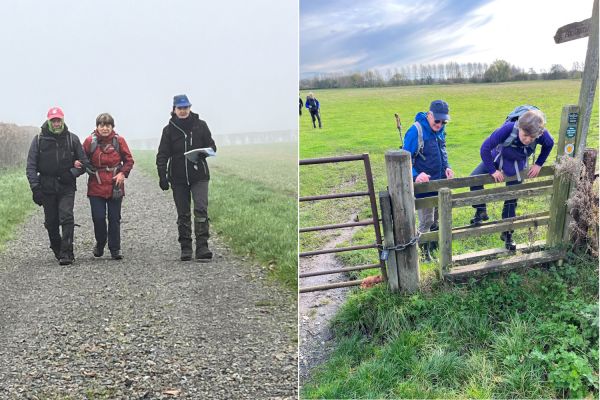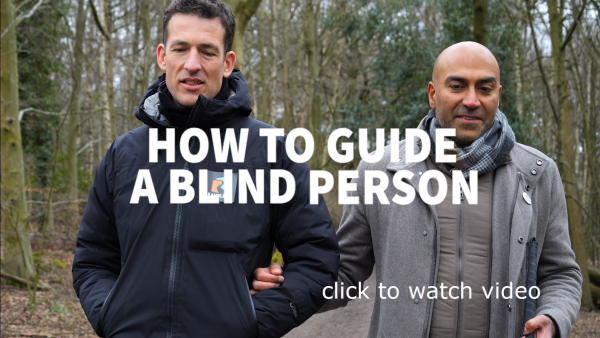10 tips on guiding a blind or partially sighted person
How to have an enjoyable and safe walk. Produced with input from Sight Support West of England.

For a blind or partially sighted person, enjoying walking in nature can be a rich and sensory experience. Amar Latif, President of the Ramblers and blind adventurer says “I like a walk where I can hear the nature, smell the wildflowers. I love going to Nidderdale where there is peace and quiet, and sheep and cattle roaming free. I love the sound of a trickling river. It makes me feel so zen.”
How sight loss can affect vision
Sight loss can mean total blindness but more common are central vision loss or peripheral vision loss. Someone with central vision loss may not see details well, if at all. They may, for example, be able to see the outline of a person's figure but may not be able to see what they look like. Whilst their sight may not be perfect, it may still be used to do many everyday tasks and to move around relatively freely. Someone with peripheral vision loss may struggle to move around freely, especially in busier areas. They may not see things on the immediate left- or right-hand side or in the distance.
10 tips for guiding a blind or visually impaired person when out walking
Guiding a blind or partially sighted walking companion can be hugely rewarding for both of you. Here are 10 tips to consider to help you make it a safe and enjoyable experience.
- Blind and visually impaired people may use any of a variety of different canes to support their mobility. But when rambling in the countryside, the most used method is a Ramble Tag. A tether is attached to the guide and the person be guided will hold on to the other end. Alternatively you can use a walking pole.
- Most guide dogs are trained in urban areas and so may not be able to follow a rural route. There will also be lots of distractions for them. The owner may let them free run or walk on the lead and will therefore need to be guided by a person.
- When arranging to meet, try to come up with a place to meet that you both know or that a taxi driver would be able to find easily. The blind or partially sighted person will not be able to recognize you and will be expecting you to find them. Remember to always introduce yourself by name.
- Converse just as you would with anyone else. Blind and visually impaired people do not want to be talked to any differently. Asking if they saw a particular TV programme last night is perfectly acceptable.
- When following a path ask the person how they would like to be guided. The person being guided will likely want to have their hand on either your elbow or shoulder. This allows them to feel movement and change of direction. They will follow roughly half a step behind. If you need to navigate a narrow pathway, let your companion know. Bring your arm around your back and straighten it up, so they can follow directly behind you.
- Look out for tricky terrain and let your companion know what you are approaching. Inclines, cobbled paving, loose stones, uneven ground and muddy paths can all be hazards.
- Beware of overhanging trees. Make your companion aware just before you approach the obstacle and tell them you are navigating around it or ask them to duck. If you choose to duck, make sure to tell them once you have cleared the obstacle.
- When approaching steps, walk ahead of the person you are guiding and let them know when you are at either the top or the bottom. If there is a handrail, ensure they know where it is and guide their hand to it if needed.
- Think about describing your surroundings such as landmarks or an interesting skyline. President of the Ramblers, Amar Latif says “When I am on a walk, I get my sighted companions to build a picture for me. And that is just like reading a book. You are building the pictures yourself. And often the book is much better than the film.”
Use clear imaginative words to bring the scene to life as if you are describing the scene to someone on the phone. Some people may even ask you to ‘draw’ the outline or shape by guiding their hand in the air.
- Always remember to say goodbye. If for any reason you must leave the blind or partially sighted person (for example to go to the bathroom) let them know that you are leaving and re-introduce yourself when you get back.
These tips should help you and your companion have a safe and enjoyable walk. But everyone is different so the most important thing is to get to know the person you are guiding and ask how they would like to be guided.
More inspiration
In this video Amar Latif, President of the Ramblers, explains how to guide a blind or partially sighted person.

Amar Latif to be appointed as President of the Ramblers
Known for his television appearances as the Blind Adventurer, Amar hasn’t let sight loss be a barrier to walking outdoors.

Walking is about more than what you can see
Ramblers member Marika has been blind since childhood, but that hasn’t stopped her from enjoying walking.
